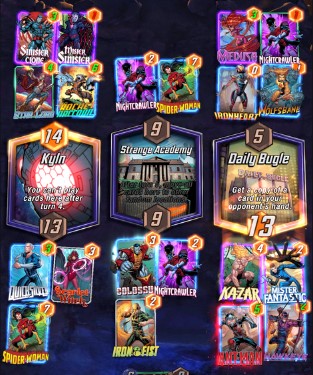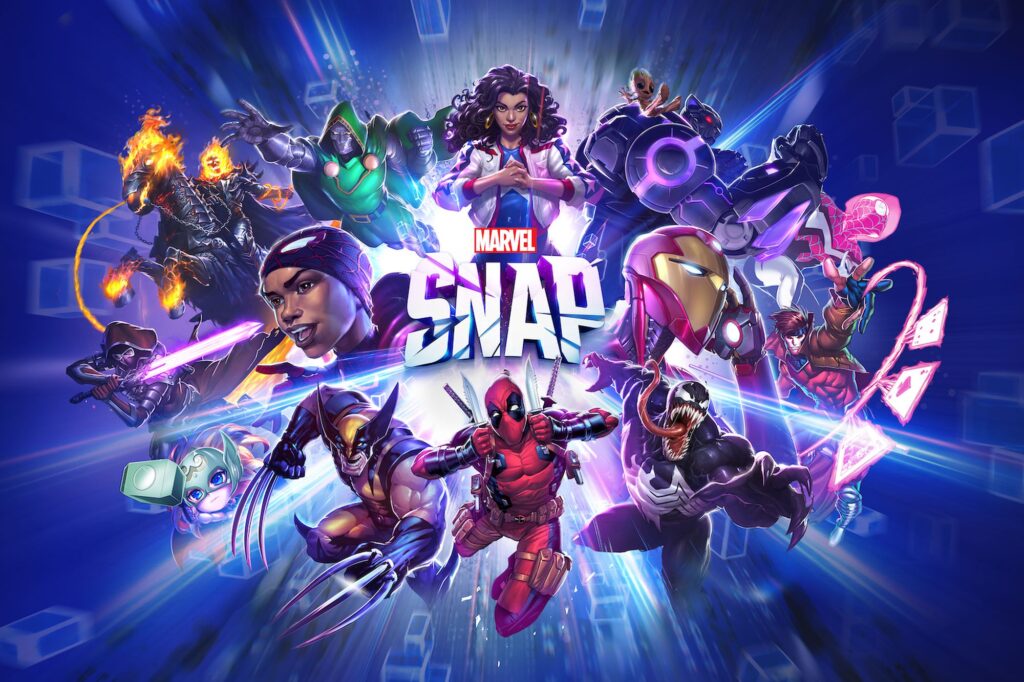About a month or so ago, Marvel Snap was launched. At first, I was very skeptical: not only was this a CCG, but also it’s a mobile gacha game, but ALSO it’s some Marvel IP thing? The odds were not looking good for me! However, I quickly noticed that this was not your average mobile card game. And almost all of the things that make it “not your average mobile card game” are good old fashioned game design: bold, systemic decisions made surrounding the ruleset.
In most CCGs, cards are typically extremely inefficient. Hearthstone is probably the banner example here. When I play a card in Hearthstone, it means very little in the grand scheme of a match. The card will almost certainly be completely gone within a turn or two, and while it exists it implicates almost nothing else in the system. There’s no real decision about where to play the card; you just play it to your field, if you have the mana, at least most of the time. CCGs have long faced the criticism that the act of actually playing them is largely a foregone conclusion (and/or too random). There are simulators like Archidekt and many others, which simulate the outcomes of a deck, and some have argued that it’s more interesting to just simulate the outcomes of two decks than it is to actually play the game (this may be a bit of an overstatement, but the point is there).

Marvel Snap has several systemic rules that, when put together, create an environment that allows cards to actually be efficient. Let me explain the most important rule changes:
- There are three lanes, of which you must win two in order to win the match. There’s no creature combat; the creatures just have a value that is compared per-lane (somewhat similar to Gwent if it had lanes).
- In each lane, are four card slots. In other words, you can only ever have a total of 12 cards down during a match (4 slots x 3 lanes).
- There are six turns in the game. After turn six, the game ends.
- Each lane has a randomly chosen “location power”, i.e. “you can’t play cards that cost 1 energy here” or “the highest power card here gets +3 power”, and so on.
These rules, when put together, mean that every card you play is of significance. And it also means that you have at least some choices, even when there’s only one card that you can play.
The three-lane rule means that it is often ambiguous what the value of a given card in a given lane is, because maybe this lane’s value won’t end up mattering (if the opponent doesn’t even play into it and only focuses on the other two lanes, for example).
The four card slot rule means that even on turn one, playing a 1-power creature in a lane is kind of a huge deal, because now that spot will (more than likely) remain at only the 1 power the whole game.
The six-turn rule also is pretty cool. I’m generally not a big fan of turn timers. Typically, they’re much longer, like in Eurogames you’ll see games with 12 turns or 20 turns, Pokemon Unite has a 10 minute timer and sports have crazy long timers. In general, I think that a flexible match length is more compatible with the strategy game form.
The location powers are maybe kind of a mixed bag, in terms of the actual design of them, but the principle is super-important: it’s a bit of strong input randomness that means you can’t just run the same strategy every game (like you kind of can, or at least hope to in MTG). I’d personally have them tone the effects of these down a tiny bit, but it’s fantastic in principle.
But in the case of Marvel Snap, I like it, for three reasons:
- Six turns, unlike 10 minutes of brawling in Pokemon Unite, is structural, especially because of the fact that you get +1 mana each turn. There’s a lot of planning that you can do around these six turns; it’s not like the game is just rolling and rolling and suddenly ends because the timer ran out. You very much are playing around this structure of six turns.
- Marvel Snap is partially a strategy game, but it’s also partially a gambling game. Like, it’s quite random, and feels somewhere between playing a game of MTG and a round of poker.
- On a practical level, it’s just super fast, and there’s basically no exceptions to this. You know going into Marvel Snap that your game will be over in under five minutes. That’s powerful!
In some ways, because of how fast it is, the fact that there are real decisions to be made every turn… I sort of feel like Marvel Snap is the first truly great, big-budget mobile CCG. That’s quite an achievement. And it’s just worth noting that this game isn’t great because of the art, or because of the music, or because of its business model, or because of anything else really (not that any of these qualities are bad, really). MTGA looks and plays just as good, in terms of its overall production value, and I actually probably prefer the aesthetics of MTGA to be honest.
But the difference is just pure, raw, old school ruleset design. That’s what made the difference, and I really appreciate it. I also feel like the changes that Snap made to CCGs are some of the kinds of things that I’ve sort of been verbally wishing for out loud: a system that’s more structural, that’s simplified in some ways but that uses rulesets in a way that allows for emergent complexity. Less inherent complexity, more coupling. I feel like people said I was crazy for even wanting something like this, like I’d get “nah that will never work” type of responses. But here it is!
I don’t know, I guess it’s just… being a game designer, someone who cares a lot about rulesets, it can feel a lot of the time like no one really cares about that, or even that it doesn’t matter. It can feel like all people care about is production value, or story, or other aesthetic qualities. But I feel like Marvel Snap is a testament to the power of game design, and makes it really feel worth pursuing.
Limitations
I’m not going to say that Marvel Snap is the greatest game of all time, or anything like that. There are a lot of board games that, if they had an app with this level of quality, I’d be all over them. It has many of the pitfalls of the classic CCG, *and* some of the pitfalls of a gacha game. There are probably too many cards already, and there’s only going to be more from here. So we can expect some really terribly designed cards; it’s only a matter of time, if they aren’t already here now.
The three lane thing is great, but there are times when you’re just kind of guessing about where the opponent will play their card, particularly on the last turn. It’s not a huge deal, but there’s a lot of “yomi” involved.
And beyond that, like I said, the game is really, really random. But the randomness is extremely mitigated by the fact that the game is so short. It’s shocking, but some super wild random stuff has happened to me in this game, and I didn’t even care really. I think there’s a lesson in here, but I really hope the lesson that people take is not “just make games shorter then”. That would suck! Longer games are great to have too, there’s a lot you can do with creating a healthy arcosphere in a longer game that just can’t be done in a game that’s over in six turns (no triangle, either!) I do think the message is, though, if you want a very random game, keep the match very short. And if you want a longer game, beware about randomness.
Addendum! I didn’t really mention this, because I’m not a huge deckbuilding guy, but it’s also really worth noting that a deck consists of just 12 cards (no copies). This is also a stroke of genius and turns deckbuilding from an oppressive slog into something even I find myself kind of enjoying. I can’t speak too much more on this, but, it sure seems good to me.
Second Addendum! This game also has a kind of silly “doubling cube” mechanism where you can press this button at any time to sort of “bet more Elo points” on yourself. Apparently, it’s important to use if you want to climb, but if I were in charge I think I might consider deleting it (it’s arguably the namesake of the game, but I think it’s fine for it to be marvel snap because it’s over in a snap). I’m not a big fan of this idea of just adding a second level of betting on the outcome of the game. When I first started playing, I thought maybe it was necessary because of how random the game is, but now I think I’d prefer if it didn’t exist. The nice thing is, it’s easy enough to ignore if you just want to play the game.
Addendum 2.1 (edit): I also have to say, I really don’t like retreating. I hate that the game gives a player a choice between “finishing the game” and “gaining more Elo points”. Like, it’s optimal to retreat in many matches, but I want to see how the rest of the game will go! Bleh! Thinking of this more really makes me dislike the cube.
Third Addendum! A lot must really be said about how good the app is. Like, the graphic design, how quickly you get into a game, how little it gets in your way… it really is just so quick and painless to do anything in the game. I also love that there’s just ONE SINGLE MODE – coming from MTGA’s 19 and a half different modes, it’s just great to be like, PLAY GAME. Very refreshing!
Amazing work, Second Dinner!
Thanks for reading! As always, you can support my work on Patreon, here.

You must be logged in to post a comment.